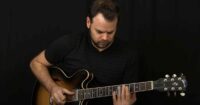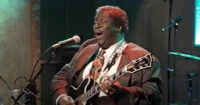Deepen your knowledge of Delta Blues with this in-depth Delta Blues Licks guitar lesson. We’ll take a typical blues progression and add several fingerstyle blues licks to help you sound better when playing acoustic blues. Great tune and great teaching!
Links:
LESSON PAGE:
POSTING SCHEDULE
New Blues focused guitar lesson posted every single Tuesday.
SUBSCRIBE to learn how to play Great Acoustic!
https://www.youtube.com/channel/UCcWT…
FREE MINI-COURSE: “Acoustic Blues Jumpstart: How to Get Started Playing the Blues”
http://www.bluesguitarinstitute.com/f…
CHECK OUT ALL THE TUESDAY BLUES LESSONS:
http://www.bluesguitarinstitute.com/t…
LET’S CONNECT!
— http://www.facebook.com/bluesguitarin…
— http://twitter.com/johnfhatcher
Blues is a musical genre known as the folklore of African-American musicians. Its origins are associated with the southern states of the USA, that is the region conventionally called the “deep south”. The very name of the genre (sadness, despair) is related to its nostalgic form, also in the textual layer. Blues pieces touch male-female relationships as well as feelings and emotions (love, loneliness, faithfulness, jealousy). However, blues performers often sing about freedom, work and travel. The songs also feature social criticism relating mainly to racial inequality and political issues.
Many artists are inspired by blues music and combine it with other styles. In this way, such musical mergers as punk blues, soul blues or blues rock. The popularity of this genre in the USA has led to the emergence of regional varieties, such as Louisiana, New Orleans, Texas and Detroit blues. There are also factions characteristic of other countries – British blues and African blues.
Contrary to popular belief, the Delta blues has nothing to do with the delta, the mouth of the Mississippi River. This incorrect name is the common name used by the inhabitants of the plain part of the Mississippi state where there were cotton plantations. This area is a plain stretching for about 200 miles from Memphis, Tennessee in the north to Vicksburg, Mississippi in the south, and is bounded to the east by the Yazoo River and to the west by the Mississippi River, but crossing it several times and entering the state Arkansas. The most important city of the Delta is Clarksdale, founded in 1882 and having today about 20 thousand. residents. On the ground floor of the Carnegie Public Library is the Delta Blues Museum.
Delta blues probably originated in the hills surrounding Delta in both Mississippi and Arkansas. Even before Louisiana and Tennessee developed their distinctive varieties of blues, the blues performed there also belonged to the Delta blues.
Thank you for watching Delta Blues Licks guitar lesson
We appreciate your time and dedication to reading our article. For more of the finest blues guitar music, make sure to follow our Facebook page, “I Love Blues Guitar”. We share exceptional selections every day. Thank you once again for your continued support and readership.












